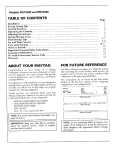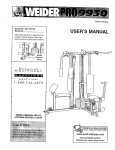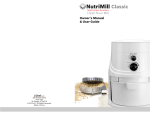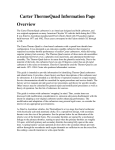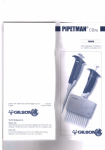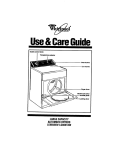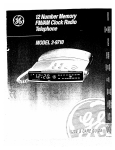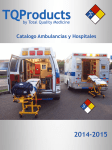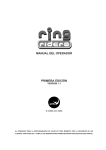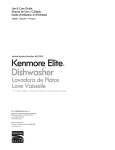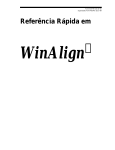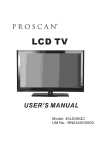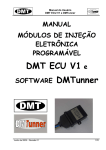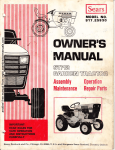Download secondary air valve opening
Transcript
' IT'S EASY m N YOU KNOW THE BASICS... Remember the fmt carburetor you took apart? Maybe you worried about getting all those parts back where they belonged, or the adjustments had you confused. But then, with an understanding of basic systems plus a look at the Service Manual, the next job went easier and it all became routine. It's still that way with new model carburetors, even far some experienced technicians. But it's not like starting over at the beginning, in spite of changes in carburetor appearance and added refinements, because underneath it all the same basic systems are still there. Following Tech's advice, we're going to assume that the basics of four-barrel carburetor operation are generally understood as we cover the ThermoQuad carburetor used on some of our '72 models. For orientation, the differences from earlier, more familiar carburetors are described rust, followed by the adjustments and some helpful servicing hints. r m E O F CWTEltrrS 1 ................ 2 ............... .......... ........... ..,,..... ........., .......7 .7 ......................... THERMO-QUAD FEATURESe...**.....*.**cer Chaste Diaphragm Operation Acwlarrator Pump Operation Swg-Up Pistm and Metering R h . HERMB-QUAD ADJUSTMENTS .e.oe..em.,. Smmdwy Throttk Link Air Valve Spring Tension., , A%Valve Openin3 R ~ @ b a t Pump ~ r 8trukar.. C b b t h n i f r ~L~~l**.a.rc..e..*m....~....m DEqahr~ C a n m r R~tlo**...*.....~**... Vaeu~rnKick Fast-ldh Cam and Linkage. Chake Unicwhr S%osfidmy Throttle Pi&-Up Lwer F ~ d - l d h B ~ r . . e . m t .1.9.0e...9. . * Curb-Idle Sped Bowl Vmt Valwar Float Height Satring THEWUWBa SERVSCINO HINTS., .4 5 6 6 ..................78 8 ............................. ................ 10 ........................... ...........ll18 ............................ 11 ............ ...,..* 12 ....,.. ..................... 12 .......13 .9 As suggested by the name, the unique feature of the Thermo-Quad carburetor is its lower operating temperature, which results mainly from the insulating properties of the molded phstie fuel bowl and the "suspended" design of the fuel metering system. Tests show that the ThermoQuad runs as much as 200 cooler than all-metal carburetors. FUEL BOWL CUTS HEAT CONDUCTION The plastic fuel bowl reduces engine heat conduction both to the fuel in the bowl and to the metering system built into the bowl cover. The metering system parts extend down into the fuel bowl and, except for the linkage and bowl cover screws, there is essentially no metal-to-metal contact to transfer heat from the engine manifold to the fuel in the bowl or t o the bowl cover metering parts. LESS HEAT IMPROVES PERFORMANCE Important advabtages are gained by holding carburetor and fueI temperatures down. For example, there is less chance of flooding due to overheated fuel expansion when the engine is shut off, especially in hot weather. And, a cooler-running carburetor maintains a more constant air-fuel mixture ratio in all operating ranges. - DESlGN LOWERS EXHAUST EMISSIONS ThermorQuad metering calibration is leaner because mixture enrichment is not needed to compensate for fuel expansion power losses. As a res u l t , exhaust emissions are reduced withaut seriously affecting engine performance. AIR MIXES IN AT DISCHARGE The '72 Thermo-Quad has a conventional, venturithroated primary section, and straight-bore, airvalve-type secondaries. in operation, the metering system feeds the primary and secondary discharge nozzles with a solid, continuous stream of fuel which mixes with air after it leaves the nozzles. This differs from '7 1 ThermoQuads and other carburetors with conventional air-bleed metering systems which introduce the air into the fuel stream before discharge from the nozzles. PRIMARY METERING HAS MANUAL CONTROL Primary fuel flow is controlled by two metering rods yoked to a single, vaeuum-operated step-up piston which reacts basically to engine loading. During the primary operation phase, the stepup piston and the metering rods are raised mechanically by a earn and lever arrangement which will be described farther on. CHOKE MSCONNECTS SECONDARIES The secondary throttle valves are mechanically linked to the primaries and begin to open at a p proximately 70 m.p.h. Dulring the choking phase, a pickup lever disengages to keep the secondary throttle valves from opening. W e n the choke opens and the fast-idle linkage moves t o off position, the pickup lever drops into position where it engages the secondary throttle linkage t o open the throttle valves. Fig. 1-BobdaeePsshmtrGrrmiw SECONDARY METERING IS CONVENTIONAL Secondary fuel flow is metered by conventional jets connected to discharge nozzles which begin deEvery when the secondary throttle valves start to Thermo-Quad carburetor are linked to the choke vacuum-kick diaphragm. CHOKE DIAPHRAGM DOES W A L DUTY In this case, the choke diaphragm does two jobs. Besides its regular vacuum-kick fmction, the diaphragm also restrains the air valve to keep it from opening too quickly. If the air valve opens before adequate flow begins at the secondary nozzles, flat spots can result. Fig 2 - C o w inch& meW n g mmp~nents open. As already mentioned, the fuel discharges in a solid stream which mixes with air after leaving the nozzles. BOWL COVER CARRIES METERING PARTS Float and needle valve assemblies, primary discharge nozzles and ventwis, accelerator pump and jet, step-up piston and metering rods, and the secondary jets and n o d e s are all part of the bowl cover assembly. Two primary metering jets and a baffle plate are the only parts located in the plastic fuel bowl. VALVES ARE LINKED TO DIAPHRAGM The bowl cover also houses a conventional choke valve and a spring-loaded secondary air valve. However, unlike similar carburetors, both valves in the F&. 3 4 0 t h vi?Iy1?8are Iinked to d i a p h q SEPARATE SETTINGS NEEDED Because the choke diaphragm has two distinct functions, separate adjustments must be made to set the air valve control and the vacuum kick. Since these adjustments are inter-related, they must be made in the sequence described in this book and the Service Manuals. THROTTLE BObV HWSES CAM AND LEVER The throttle body section forms the mounting flange of the carburetor and houses the primary and secondary throttle valves. The step-up piston cam and lever are also located in the throttle body. SOLENOID OFERMINES IDLE SPEED A curbidle speed solenoid is mounted on the carburetor throttle body casting or on the intake manifold on the throttle lever side. This solenoid maintains a relatively high idle speed when the engine is running, but retracts when the ignition is t m e d off so the throttle can close farther to prevent "after-running". Choke Diaphragm Operation As in other carburetors, engine vacuum moves the choke diaphragm inward to produce vacuum-kick action. However, the Thermo-Quad diaphragm stem is linked directly to the secondary air valve shaft lever by a connecting rod which also picks up the choke adjusEing lever. This pickup action produces the vacuum-kick opening of the choke valve. SECONDARI ES STAY CLCEED White the engine is warming up with the choke an, a tang on the fast-idle operating lever lifts the secondary throttle pickup levsr and disengages the secondary throttle: linkage. This prevena the sets ondary throttfe valves from opening when the choke is an,even if the pedal is floored, throttle valve and does not affect diaphragm vacuum as long as the valve is closed. DIAPHRAGM VACUUM ORStOWt7 When the secondary throttle valves open, manifold vacuum drops abruptly but the drop in the diaphragm is slowed by restrictions at the bleed port and in the vacuum passage to the diaphragm. Fig & L m p k k s up m m d w y linkage PICKUP LEVER ENGAGES LINKAGE The secondary throttle pickup lever drops and engages the throttle linkage when the fast-idle linkage moves to its off position. The secondary throttle valves can then open in a normal manna, but as long as these valves m cbsed, the choke diaphragm holds the secondary air valve closed. PASSAGE IS OPEN TO MANIFOLD Vacuum is routed to the choke diaphragm through a passage which connects to a chamber in the bottom of the throttle body. This chamber is open to manifold vacuum regardless of throttle position. VACUUM BLEED PASSAGE ALSO USED In addition, a bleed passage extends from the diaphragm vacuum passage to a small port in the secondary bore on the choke diaphragm side of the carburetor. This port is closed by the secondary DASHPOT ACTION CONTROLS VALVE As the vacuum bleeds off, the choke diaphragm acts as a dashpot, preventing the secondary air valve from opening too quickly. As a result, incorning air flow opens the air valve at a rate which provides smooth pickup of the secondary discharge nozzle operation. PUMP LINK CONYROCS TRAVEL Because less ~ u m poutput is needed at higher speeds in ~or&e~litae~uipped models, the p&p plunger "S" link angles outward at its m t e r so the link cm move over-center. This arrangement re dwes plunger b v e l when the throttle is in the higher speed range. Accelerator Pumu Ooeratit The Thermo-Quad accelerator pump cylinder is part of the bowl cover casting and connects to its discharge jet in the primary section through a short flexible tube. The intake check valve assembly acts as a bottom closure for the pump cylinder. 7 Fia IO-Over-center action cubplur F;g. 8 - A d m m r pump Ts buitt tnm q kEk.D uijhE.-f mgnirnirGbEL! PLUNGER $HAFT REMOVES VALVE The intake check valve assembly fits tightly intc the bottom of t h e pump cylinder and can be rem o ~ by d tapping k h t l ~on the end of the pump plunger shaft. Tap the plunger end -fully to guard against damage to the shaft guide lugs cast ' into the bowl cover. Fig. S-T q &aft end to remove chmk valve N f pump output must be available longer for smoith accelmation of manual transmission models, so a two-stagt: linkage with a pump stroke pickup lever is used. This model requires two m a ,te gump adjustments, which must be in sequenm, CAM AND L M R R A M L l ' n ROD For its mechanical operation, the step-up piston has a lift rod which extends down through a passage in the fuel bowl into the throttle body, The bottom end of the rod rides on a lever operated by a cam on the primary throttle shaft. Fig. 12-Wrong link paition can mse h 8 w p INSTALL "S" LINK PROPERLY Because the accelerator pump plunger link is angled for over-center operation, there is a wrong way and a correct way to install it. The link wiIl go on either way, but can hang up overcenter if the top part of the "S" points inward instead of out, The correct instaIlation is shown in an accompanyh g illustration. In the Therrno-Quad primary metering section, the two metering rods are yoked to a single step-up piston which rides in a cylinder in the bowl cover casting. As mentioned earlier, the primary jets which work with the metering rods are located in the p b t i c fuel bowl. CTFP - IIP LIFTlNG ACTION FOLLOWS THROTTLE In the low- and medium-speed range, the crun and lever lift the step-up pistan and metering rods in proportion to the primary throttle valve opening. This action provides positive mixture control regardless of variations in engine vacuum. Fig. 1!5-Cam providsls N t & e mixturn ~ n t r o l VACUUM BALANCES SPRING FORCE As the secondary throttle valves open, the step-up piston operates the metering rods in the conventional manner. Vacuum on the piston balances against spring force to position the metering rods and vary the mixture as required by changes in operating conditions. C iI TAMPER1NO IS A NO-NO The length of the stepup piston lift rod is factoryadjusted on equipment not available in service. Tampering with the setting will upset performance and emission control, so it should not be disturbed. 1JERMO-QUAD ADJUSTMENTS Before you touch any carburetor adjustment, f ~ s t check out all other possible trouble sources.Then, if linkage adjustments are needed, make them in the proper sequence so one adjustment does not undo preceding ones. Nearly all Therrno-Quad adjustments can be made on or off the engine. However, the carburetor must be removed to check or adjust the secondary throttle link. Fast-idle speed, curb-idle speed, and bowl vent valve settings are adjusted with the carbwetor installed. I Secondary Throttle Link To check the secondary throttle link setting, the choke valve must fist be blocked open. This lowers the outer tang on the fast-idle operating lever so the secondary throttle pickup lever moves into position to open the valves. To cover the Thermo-Quad adjustments, we'll describe each external setting in the order recammended for a complete checkout. Adjustments which can be made separately are indicated. In general, adjustments which require bending must be made in sequence. THERMO-OUAD ADJUSTMENT SEQUENCE * * @ SECONDARY THROTTLE LINK SECONDARY AIR VALVE OPENING AIR VALVE SPRING TENSION ACCELERATOR PUMP STROKE CHOKE CONTROL LEVER CHOKE DIAPHRAGM ROD VACUUM KICK FAST-IDLE CAM & LINKAGE CHOKE UNLOADER SECONDARY THROTTLE PICKUP LEVER FAST-IDLE SPEED CURB-IDLE SPEED BOWLVENTVALVE Slowly open the primary throttle valves the specified distance from the throttle bare walls. At this point, the secondary throttle valves should just begin to open. To adjust the setting, bend the throttle link mfully at the angle. Be sure to sup port the h k while bending so the connecting levers will not be distorted. Air Valva Opening Air Vatve Spring Tension The secondary air valve opening adjustment comes next in the sequence, but can be made separately. First make sure that the air valve is aligned when closed, with the valve edges parallel with the inner walls of the valve opening in the fuel bowl cover. The secondary air valve spring tension adjustment follows the valve opening adjustment, and can also be made separately. To begin, you first loosen the hollow spring-adjuster lock plug with the special C4152 tool. This releases the spring windup tension and allows the air valve to drop open. 8 1 %COWRY AIR VALVE F& 17- V& must be a/@& in qmnIng Next, open the air valve against its stop and check for the specified gap between the valve edge and the outer wall of the primary air horn section. Bend the notched corner section of the air valve to adjust the opening if needed. Fig I S T i S f i r n lock plug m hoJldspdtzg sming THE TOOL IS 1-IOLLOW Insert a screwdriver blade through the special tool and bring the air valve back up with initial spring windup tension until the valve lip contacts its closing stop lightly. To do this, you turn the adjustment plug countercIockwise gradually as you test for light closing contact by applying repeated opening pressure on the air valve. WIND UP THE SPRING From the initial air valve closing position, continue to turn the adjusting plug the specified number of turns in the windup position. At this point, t@ten the hollow lock plug with the special tool to hold the adjustment secure, Accelerator Pump Stroke Fig. I&Ho/d valve w i n s &stop to chmk opening The basic accelerator pump stroke adjustment procedure is the same on a l l ThermoQuads. Begin with the choke valve wide open and the fast-idle cam in the off position. Then turn out the throttle stop screw so the throttle valves can close cumpletely. Also make sure that the hooked end of the Choke Control Lever I I To check the choke control lever setting with the carburetor on the engine, you first remove the stainless-steel choke well from the manifold so you can use the top surface of the well opening & a reference point for the measurement. PUMP STROKE ADJUSTMEN: b'. .BACK OFF CURBeIDLE SCREW BENO - 1 - ?I1 (sf THROllLE CIJNMECTOR ROD Fig. 2lFCheck H i n g w'tb throttle vakes closed ESTABLISH A REFEREE€ POINT When checking with the carburetor off the engine, you set the carburetor base down on a flat surface which extends the base or flange line out under the choke control lever. This provides the lower reference point for the measurement. throttle connector rod is in the specified hole in the pump arm. CLOSE THROTTLE VALVES COMPLETELY Apply light force on the throttle lever to hold the primary throttle valves closed. Measure the distance from the top of the plunger shaft to the top of the bowl cover. If this dimension does not meet the specifications, bend the throttle connector rod at the angle to correct. Fig. 2SHoEd measuring scale wmical -+ , . ( \ OPEN THROTTLE UNTIL SECONDARY LEVER BEQMS TO MOVE fig 21-Pkkup arm on mnuaI-shiftmodels only MANUAL SHIFT ADDg A STEP On m a n d transmission carburetors, you continue beyond the basic pump stroke setting by opening the throttle slowly until the secondary throttle shaft begins to move. Hold this position and again measwe the stroke as before. If adjustment is needed, bend the pickup arm on the primary throttle shaft dog. MEASURE VERTICAL DlSTANCE To check the choke control lever setting on or off the car, open the throttle slightly to free the fastidle linkage and push on the choke control lever to hold the choke valve closed. Then check the vertical distance between the top of the hole in the lever and the lower reference surface. To adjust the setting, carefully bend the choke connecting rod at the angle. After checking the choke control lever setting, we move on to the choke diaphragm. For the choke diaphragm connector rod adjustment and the vacuum-kick adjustment which follows, the choke diaphragm stem must be fully retracted by engine vae uum or by vacuum from an external source. RQD W E S NOT SET VACUUM KICK Unlike ather carburetors, the Thermo-Quad choke diaphragm connector rod adjustment determines the secondary air valve closing gap instead of setting the vacuum kick. You begin the connector rod check with the diaphragm stem retracted and the air valve in closed position. Frjp 24-Mockrlatfngsprtna must be e x W EXTEND MODULATING SPRINa With the choke diaphragm stem retracted, apply light closing force bn the choke control lever to extend the modulating spring and move the choke vdve to the kick position. Use a specified drill or gauge to measure the kick opening. Fi& 23- Rod I- &twmIm valve posrposrtio~ SYW IS IN CASTING Check for the specifred clearance between the secondary air valve lip and its dosing stop on the bowl cover casting. If adjustment is needed, bend the choke diaphragm connector rod at the angle. rn If you check the vacuum kick with the carburetor off the engine, first open the throttle so you can move the choke and fast-idle linkage to the closed position. Then release the throttle to trap the fastidle cam in closed position. The choke diaphragm stem, of course, must be fully retracted. ON-ENQINE ADJUStMENf The same preliminary procedure can be used on the engine if you use an external vacuum source. However, when engine vacuum is used, you back off the fast-idle speed screw until the choke can be closed to the kick position at curb idle with the idle speed solenoid core fully extended. Note the number of twns backed off so you cztn restore the setting afterward. A W S T FOR SLIGHT DRAG You should be able to fed a slight drag when the driU or gauge is removed. To open or close the kick setting, bend the tang on the choke adjusting lever. PREVENT LEVER #STORTION The choke adjusting lever must be supported while the tang is bent or the choke control lever adjustment may be disturbed. For support, insert a screwdriver blade end in the "U"-shaped opening Fig 2Y-Support lever Menbending tang Fig 28-Gwp ahartd withthw 4 t h d@t drag between the adjusting lever and the choke countershaft which passes through it. measured between the lower edge of the choke valve and the air horn wall. To adjust the valve opening, YOU bend the angle. the %#-idle wnnector rod at The next step in the Themo-Quad adjustment sequence is the fast-idle cam and linkage setting. To begin this adjustment, you fust position the fast-idle operating lever by putting the fast-idle speed adjusting screw on the second step and against the shoulder of the first step of the cam. CLOSE VI&# FOR MEASUREMENT W~thlight closing force on the choke control lever, the choke valve must open the specified amount, After the fast-idle cam and linkage setting, the choke unloader adjustment is next. Since the unloader operation permits maximum inlet air flow through the wburetor to overcome flooding, we check the setting with the throttle in the wideopen position. CLOSING FORCE EtlMlNAlES ERROR Here again we apply light closing force on the choke control lever and measure the amount that the choke valve opens. A light drag as the drill or gauge is removed is okay. Bend the unloader tang on f Re fast-idle operating lever to adjust. Secondarv Throttle Pick-Up Lever The secondary throttle pickup lever adjustment wraps up the settings which can be made with the carburetor off the car. To check the lever setting, you bold the choke control lever in the open choke position, allowing the throttle pickup lever to drop and then measure the clearance between the pickup lever and its stop. Bend the outer tang on the fast-idle operating lever to adjust the clearance. SECDNDARY PICKUP EVER ADIUSTMEMT L ' .L d ADJUST TO SPEElFlED SPEm SPEED $*ADJUSTMENT . Start the engine without disturbing the position of the speed screw on the fast-idle cam and allow engine speed to settle down. Adjust the scmw to get the specified speed and then cycle the fast-idle spoed screw on and off the cam to double-check the adjustment. The next adjustment combines two settings, curaidle speed and the throttle stop screw, otherwise known as the slow curb-idle speed screw.Since the tie-in between idle speed and mixture adjustments is generally understood, we'll skip the mixture adjustment details here. CURB- IDLE SPEED ADJUSTMENT Earlier, we set the fa@-idle and linkage, so m w we're ready fur the fast-idle speed adjustment, which em be made out af sequence. The engine should be tmmed up and the bade &@tiontiming comedy set before you adjwt the fast-idk spedPOStTlON SCREW ON CAM First, with the engine stopped, open the throttle sUghfly to allow the fast-idle cam ta engage the speed adjusting screw.Move the choke valve closed so the speed adjusthg s m is positioned on the mmnd step of the cam against the shoulder of the fast step. TUM THROTlK STOP SOLENOID MUST BE ENERGIZED You adjust the curbidle speed with the engine warmed up and running. Snap the throttle to make sure that the curb-idle solenoid core is fully extended and adjust the idle screw to get the specified speed. ating lever at the notch if adjustment is necessary. After checking the valve opening, install a new plug in the bowl cover checking hole. FINISH WITH STOP SWINIP With the engine running at curb-idle speed, and the solenoid core extended, turn the throttle stop screw in until it just touches its stop. Then back it out one full turn to make the fmal setting. Although float height setting is not an extemal adjustment, it is the only remaining T h e m m a d adjustment not covered, so we'll describe it here. If the floats are removed, they should be replaced in their original locations. Also, make sure that both floats are free to move up and down without rubbing on the fuel bowl walls. I 1 The final external TPremrosetting is the b w i vent valve adjustment, which must b.6 made aft^ curbidle speed is stst. First, remove the deck.@ M e plug fmm the bowl wvet' and set the t h t t h at the wb-idle podtion d t h the curbidle soImoid gore a x t m d d . CHECK VERWCAL DlMENSlON You check float height with the bowl mover inverted so the floats can rest on their needle valves. Make the measurement from the gasket to the bottom swface of the float at the outer comer. Fie!S C o n t s c t wrnt vahre Ibhtly DO NOT BEND FLOAT LIP To adjust float height, bend the float lever at the READ SETTING ON SCALE To measure the vent vdve setting, insert a narrow scale into the checking hole to make light contact with the spring-loaded valve. Bend #he vent oper flat section near the lip end. Lift the float when adjusting so the lip on the float lever does not press against the needle valve. If the lip is distorted, the float can hang up. /---------I \ 1 ---------=--- -1\ -===-c, -/-- - c - C - \ -s7 &'------ 0 \\ /------ -\ \ , -----C- L+-- -/==-=- ----------------- I c------ -\ a : THERMO-QUAD SERVICING HINTS To prevent darnage, the metering rods should be installed after the carburetor sections are assembled. Position the upper rod ends inward in the ends of the step-up piston yoke and carefully install as an assembly to prevent bending the rods or yoke ends. CHECK mSEALS Before you install the bowl cover, make sure the "O-ring seals are in place in both primary nozzle wells. If either or both seds are left out, fuel will bypass the metering system and cause an over-rich driving mixture. PINS CAN SLIDE OUT When you install the bowl cover assembly, make sure that the float lever pins are in correct position. If a displaced float pin is trapped between the gasket surfaces when the bowl cover screws are tightened, the bowl wall may crack. Also note that the nozzle well "0-rings can produce a slight separation between the bowl and bowl cover until they are compressed by tightening the cover screws. r ' MAKE SURE "0" R W I B ARE PLACE[ Fig 35-Float pin can slb wt of pasrpasrtion 1 , ,= . , . - ~ ~ d : . ?',.' - 4 ; . fa. L 4 -w Fig. 3 H m h d ring CBLIWS over-rich mix hrnr USE THE RIGHT SPRING The vacuum-kick modulating spring used with carburetors on TorqueFlite models is cobred for identification. The manual transmission model spring has a different tension rating and is a piain metal color. Interchanging these springs will upset the basic choke calibration and can cause cold-start stalling. Overstretching the spring can also upset the choke kick operation. The modulating spring can be unhooked accidentally and lost, so keep an eye on it. VALVE SCREW8 MUST BE SEWRE If you loosen or remove air, choke, or throttle valve screws, secure them after retightening to prevent them from loosening under vibration and hopping out. Even though these screws are smafl, they can seriously damage the engine if drawn in. Upset the screw ends with plier pressure or use support so you can peen the screw ends without bending the shafts. HANDLE WITH CARE Be careful when you remove or install the air cleaner to prevent damage t o the vertical vent tubes or the exposed step-up piston yoke, Slight bending or distortion at the yoke ends can result in binding, especially with the piston in the raised position.















